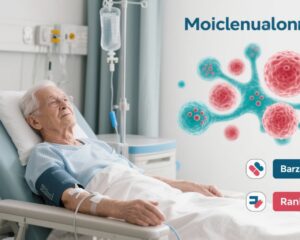Study Background and Disease Burden
Fractional exhaled nitric oxide (FeNO) is a recognized biomarker used widely in clinical practice to aid in the diagnosis, phenotyping, and management of asthma. It serves as a non-invasive marker of eosinophilic airway inflammation, which is characteristic of certain asthma phenotypes. However, interpreting FeNO values in clinical practice requires accurate knowledge of normal reference ranges, especially as values may vary with age, sex, and physiological as well as environmental factors. While FeNO thresholds have been proposed, existing data primarily come from patient populations or limited age groups; comprehensive reference data spanning the lifespan in respiratory healthy, non-smoker, non-atopic individuals remain sparse. This knowledge gap hinders the precise clinical application of FeNO testing across diverse patient demographics and risk profiles. Understanding normal FeNO values and their determinants across the lifespan is critical to improve diagnostic accuracy, personalize treatment, and prevent misclassification in asthma and other airway inflammatory diseases.
Study Design
This investigation utilized data from the Lung, hEart, sociAl, boDy (LEAD) cohort, a large, observational population-based study conducted in Austria. The cohort includes participants aged 6 to 82 years, representing a broad spectrum of the general population. For this analysis, 2,251 participants were selected after excluding individuals with respiratory diseases, atopy, or smoking history, ensuring a respiratory healthy, non-atopic, and non-smoking population for establishing normative FeNO values. FeNO measurements were obtained following standard guidelines. Additional collected data included body measurements, blood eosinophil counts, total immunoglobulin E (IgE) levels, spirometry results, and environmental factors such as urban or rural living. The study employed median and interquartile range statistics and undertook multiple regression analyses to identify associations and independent predictors of FeNO levels across two age strata—children/adolescents (<18 years) and adults (≥18 years).
Key Findings
The median FeNO level in the entire respiratory healthy cohort was 13.0 ppb (interquartile range 9.0 to 20.0 ppb), with values generally increasing with age. Notably, participants younger than 18 years had a median FeNO of 9.0 ppb (7.0 to 12.0), whereas adults demonstrated higher median levels at 15.0 ppb (11.0 to 22.0). A significant sex difference was observed among participants aged 18 and older, where females had consistently lower FeNO levels compared to males, a difference that was not present in the pediatric group.
Multivariable regression analyses revealed that greater body height and higher blood eosinophil counts correlated with increased FeNO, shared across both children/adolescents and adult groups. In children and adolescents, higher FeNO was also positively associated with total IgE levels—suggesting an immunological influence—even within this non-atopic population. Lung function as measured by the forced expiratory volume to forced vital capacity ratio (FEV1/FVC) had a positive correlation with FeNO in this group, possibly reflecting airway caliber effects. Additionally, urban living environment was identified as a factor linked to elevated FeNO, indicating possible environmental influences on airway nitric oxide production.
In adults, beyond the positive association of FeNO with advancing age, the presence of cardiovascular disease and ischemic vascular conditions was inversely associated with FeNO levels. This novel finding suggests that systemic vascular health may modulate airway nitric oxide signaling or production, underscoring the complexity of interpreting FeNO in adults with comorbid cardiovascular conditions.
Collectively, these findings define age-specific reference ranges for FeNO in a carefully characterized respiratory healthy population and highlight key biological and environmental determinants of FeNO throughout life.
Expert Commentary
The study by Bal et al. significantly advances our understanding of normal FeNO values across the lifespan. By focusing on a large, respiratory healthy, non-atopic, and non-smoking cohort, it mitigates many confounders that have complicated prior research. The demonstration of sex differences emerging in adulthood reinforces the need for sex-specific FeNO thresholds in clinical practice. The associations with height, eosinophils, and IgE levels align with known biology, as taller individuals may have larger airway surface areas and eosinophils and IgE reflect subtle immune activation. The environmental impact of urban living could reflect pollution or allergen exposure, emphasizing the importance of contextualizing patient environment when interpreting FeNO.
The inverse relationship of FeNO with cardiovascular disease in adults is intriguing and warrants further investigation to understand underlying pathophysiological links and potential implications for FeNO interpretation in patients with systemic vascular disease.
Limitations include the observational nature of the study and lack of longitudinal FeNO measures, which could shed light on intra-individual variability. Nonetheless, these robust cross-sectional data provide a valuable clinical framework.
Conclusion
This comprehensive study establishes reliable, age- and sex-specific reference ranges for fractional exhaled nitric oxide in a respiratory healthy, non-atopic, and non-smoking general population. It identifies key determinants—including body height, eosinophil counts, IgE levels, urban living, and cardiovascular comorbidity—that influence FeNO measurements during different life stages. These insights render FeNO a more precise and context-sensitive tool in clinical practice. Incorporating these normative values can improve asthma diagnosis, phenotyping, and personalized therapeutic decisions and help avoid misinterpretation of FeNO results in diverse patient populations. Future research should explore longitudinal changes, mechanistic pathways linking vascular health to FeNO, and whether tailored FeNO cutoffs enhance clinical outcomes in respiratory diseases.
References
Bal C, Schiffers C, Breyer MK, Hartl S, Agusti A, Karimi A, Pohl W, Idzko M, Breyer-Kohansal R. Fractional exhaled nitric oxide in a respiratory healthy general population through the lifespan. Pulmonology. 2025 Dec 31;31(1):2442662. doi: 10.1080/25310429.2024.2442662. Epub 2025 Jan 6. PMID: 39760541.
Additional contextual references:
1. Dweik RA, et al. An Official ATS Clinical Practice Guideline: Interpretation of Exhaled Nitric Oxide Levels (FeNO) for Clinical Applications. Am J Respir Crit Care Med. 2011;184(5):602-615.
2. Global Initiative for Asthma. Global Strategy for Asthma Management and Prevention, 2024 Update.
3. Smith AD, et al. Use of exhaled nitric oxide measurements to guide treatment in chronic asthma. N Engl J Med. 2005 May 19;352(21):2163-73.



